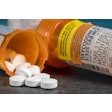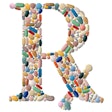
NEW YORK (Reuters Health) - Nonsteroidal anti-inflammatory drugs (NSAIDs) are safer than opioids for elderly patients, according to a study published in the December 13/27 issue of Archives of Internal Medicine.
While nonsteroidal anti-inflammatory drugs (NSAIDs) increase the risk of bleeding and other problems, the investigators found that elderly people on opioids had higher rates of fracture, cardiovascular events, hospitalizations, and death.
And even though doctors have long believed that all opioids have generally the same risks, lead author Dr. Daniel Solomon at Brigham and Women's Hospital in Boston and colleagues found some appeared to carry higher risks than others.
"People have somehow believed opioids to be safer," Dr. Solomon told Reuters Health. "Our data suggest that is not always the case."
Ironically, doctors have often prescribed opioids instead of less powerful pain medications out of concern of side effects. When scientists discovered the selective COX-2 inhibitors, the hope was they would lower the risk of ulcers among chronic users of NSAIDs.
But most COX-2 inhibitors ran into safety issues a few years after their approval, and now only Pfizer's Celebrex (celecoxib) remains on the U.S. market.
The latest findings now suggest opioids may not be any safer -- and may even be more harmful.
To compare the safety of opioids to NSAIDs, Dr. Solomon and his team analyzed data on 4,280 elderly people given opioids for arthritis pain, 4,280 matched patients who took over-the-counter NSAIDs such as ibuprofen, and 4,280 given a prescription for a COX-2 inhibitor. The mean age was 80 years, 85% were women, and none of the subjects had a history of nursing home use.
The incidence rates for cardiovascular events per 1000 person-years were 77 in patients taking over-the-counter pain medicine, 88 in COX-2 inhibitor users, and 122 in opioid users.
Incidence rates for fractures per 1000 person-years were 26 with the nonselective NSAIDs, 19 with COX-2 inhibitor users, and 101 with opioids.
The opioid-treated patients and over-the-counter NSAID users were equally likely to have gastrointestinal bleeding, whereas COX-2 inhibitor users were only half as likely to have that complication.
Compared to NSAID users, the opioid users were 68% more likely to be hospitalized; COX-2 inhibitor users were not at higher risk for this outcome.
In a separate study in the same issue of the journal, Dr. Solomon and his team reviewed data collected from equal numbers of older adults receiving codeine, hydrocodone, oxycodone, propoxyphene (now off the market because it causes arrhythmias), and tramadol -- more than 6,000 patients in each category.
After 30 days of use, each group had a similar risk for cardiovascular events. By 180 days, however, this risk was 60% higher in patients on codeine compared to those on hydrocodone.
Also at 180 days, and again with hydrocodone as the referent, the relative risk for fracture was 1.08 with codeine and 1.02 with oxycodone -- but only 0.32 with tramadol.
People taking oxycodone and codeine had more than twice the risk of dying within 30 days and within 180 days after starting therapy, also relative to hydrocodone users.
Dr. Solomon said he continues to "carefully" prescribe opioids, while explaining the risks that come with these prescriptions to patients.
But, he and his colleagues point out, "by one year the numbers needed to harm for opioid users were small and thus clinically relevant."
They conclude, "The recent concerns raised about opioid use in nonmalignant pain syndromes appear warranted on the basis of these data."
By Alison McCook
Sources:
https://link.reuters.com/muz32r
https://link.reuters.com/nuz32r
Arch Intern Med 2010;170:1968-1978,1979-1986.
Last Updated: 2010-12-16 9:00:47 -0400 (Reuters Health)
Copyright © 2010 Reuters Limited. All rights reserved. Republication or redistribution of Reuters content, including by framing or similar means, is expressly prohibited without the prior written consent of Reuters. Reuters shall not be liable for any errors or delays in the content, or for any actions taken in reliance thereon. Reuters and the Reuters sphere logo are registered trademarks and trademarks of the Reuters group of companies around the world.















